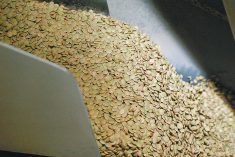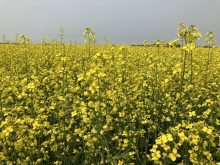Mountain snow packs are natural reservoirs, holding back winter precipitation and releasing it over summer when water demand is high.
However, the uncertainty of climate change has researchers questioning how reliable those stores may be in the future.
John Pomeroy of the University of Saskatchewan said spring snow could be replaced by more rain that runs off quickly if Western Canada warms up by 4 C as some climate change models suggest.
“With the four degrees warming, you have lost about 60 percent of the snow pack and it is melting out a month earlier,” he told the Alberta Irrigation Projects Association annual meeting in Calgary Feb. 23.
Read Also

Growth plates are instrumental in shaping a horse’s life
Young horse training plans and workloads must match their skeletal development. Failing to plan around growth plates can create lifelong physical problems.
“That is a simulation. We don’t know if it is real or not, but it shows the sensitivity of the system.”
Researchers already know stream flows from the Rocky Mountains have declined 11.5 percent since 1900. Measuring mountain snow helps predict how much water could flow through Alberta rivers into Saskatchewan and Manitoba, where it eventually ends up in Hudson Bay.
The natural flow of the South Saskatchewan River as it leaves Alberta has dropped 40 percent in the last 90 years. Two-thirds of the decline is due to consumption and the rest is due to change in mountain hydrology. Pomeroy and others link that shift to climate change.
Pomeroy said glaciers are another form of reservoir. While they do not release much water, they are important in drought years and can stabilize stream flows.
The North Saskatchewan River basin lost 147 glaciers between 1975 and 1998, while the South Saskatchewan River basin lost 181 glaciers.
“The only real source of water is rain and snow melt,” said Pomeroy, who holds the Canada chair in water resources and climate change at the U of S and is on sabbatical studying the alpine snow that fills Alberta rivers.
While melting glaciers play a role, researchers are more concerned about changing snowfall patterns.
Snow cover disappeared 30 to 40 days sooner in the February to July period between 1972 and 2000. That changes the timing of water that is released into the rivers.
Scientists are monitoring the changes to predict future supplies.
Pomeroy said more observations are needed but there are not enough stations to measure weather, hydrometrics and snow pack to predict future stream flows with confidence.
“With that range of uncertainty, I don’t think you can make policy decisions.”
Water researcher Stewart Rood of the University of Lethbridge said more water needs to be conserved for environmental sustainability.
He has looked at the history of cottonwood trees in the South Saskatchewan River basin and found about half have died since 1950 because of drought.
“River ecosystems need in-stream flow,” he said.
The allocation for the southern tributaries of the Oldman River is 118 percent, and a crisis has been averted only because licence holders have not taken their full entitlement.
“The current allocations of the southern tributaries is too much,” Rood said.
Rivers were once rated according to minimum in-stream flow needs. This was the minimum amount of water needed to support life such as fish and trees. The new practice, called environmental flow, works to maintain healthy ecosystems and is regarded as a better use of water.















